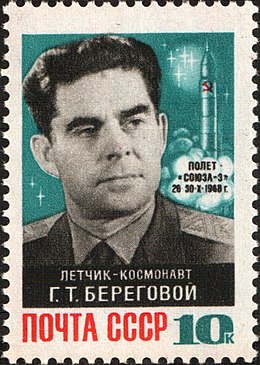Soyuz 3

Soyuz 3 commemorative postage stamp, USSR, 1968
|
|||||
| Mission type | Test flight | ||||
|---|---|---|---|---|---|
| Operator | Soviet space program | ||||
| COSPAR ID | 1968-094A | ||||
| Mission duration | 3 days, 22 hours, 50 minutes, 45 seconds | ||||
| Orbits completed | 81 | ||||
| Spacecraft properties | |||||
| Spacecraft type | Soyuz 7K-OK | ||||
| Manufacturer | Experimental Design Bureau OKB-1 | ||||
| Launch mass | 6,575 kilograms (14,495 lb) | ||||
| Crew | |||||
| Crew size | 1 | ||||
| Members | Georgy Beregovoy | ||||
| Callsign |
Аргон (Argon - "Argon") |
||||
| Start of mission | |||||
| Launch date | 26 October 1968, 08:34:18 UTC | ||||
| Rocket | Soyuz | ||||
| Launch site | Baikonur 31/6 | ||||
| End of mission | |||||
| Landing date | 30 October 1968, 07:25:03 UTC | ||||
| Orbital parameters | |||||
| Reference system | Geocentric | ||||
| Regime | Low Earth | ||||
| Perigee | 183 kilometres (114 mi) | ||||
| Apogee | 205 kilometres (127 mi) | ||||
| Inclination | 51.7 degrees | ||||
| Period | 88.3 minutes | ||||
|
|||||
Soyuz 3 ("Union 3", Russian: Союз 3) was a spaceflight mission launched by the Soviet Union on 26 October 1968. Flown by Georgy Beregovoy, the Soyuz 7K-OK spacecraft completed 81 orbits over four days. The 47-year-old Beregovoy was a decorated World War II flying ace and the oldest person to go into space up to that time. The mission achieved the first Russian space rendezvous with the unmanned Soyuz 2, but Beregovoy failed to achieve a planned docking of the two craft.
The Soviet space program had experienced great success in its early years, but by the mid-1960s the pace of success had slowed. While the Voskhod programme achieved the first multi-crewed spaceflight and first extravehicular activity, problems encountered led to its termination after only two flights, allowing the United States to surpass the Soviet achievements with Project Gemini. The Soyuz programme was intended to rejuvenate the program by developing space rendezvous and docking capability, and practical extravehicular activity without tiring the cosmonaut, as had been demonstrated by the US in Gemini. These capabilities would be required for the Salyut space station program. Soyuz 1 had been launched with the goal of docking with the manned Soyuz 2 craft, but even before the second craft was launched, problems with Soyuz 1 made it clear that Soyuz 2 had to be canceled before the landing of Soyuz 1. This saved the lives of the three-man Soyuz 2 crew; Soyuz 1 ended with the death of cosmonaut Vladimir Komarov on 23 April 1967, due to a faulty parachute system. Soyuz 2 would have flown with the same defective system as Soyuz 1. As a result, the Soyuz spacecraft was revised for Soyuz 2 and Soyuz 3 in 1968.
...
Wikipedia

